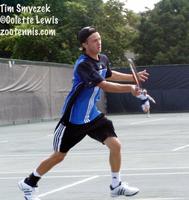Clay Impressions
--Clay Impressions
©Colette Lewis—2005
The USTA Boys 18 & 16 Clay Court Championships were quite an experience. The heat and humidity were right up there with College Station Texas, but alas, no air-conditioned press box where I could retreat. The first few days were brutally hot, and it was no surprise that heat exhaustion led to many retirements, some withdrawals and an occasional ambulance trip, as in the case of Clancy Shields. I’m not sure if the lack of those reactions at the NCAAs this year was due to the better conditioning of college athletes or the age/experience of the competitors or the surface, which prolongs exposure. 
The commitment to chair all matches—singles, doubles, consolations—was a noble one, but because several umpires also fell victim to the temperatures, their diminished ranks resulted in lengthy delays, some approaching three hours at the main site. When plenty of ITF and USTA tournaments go several rounds into the main draw without chair umpires, chairing early round consolation and doubles matches was probably a luxury the players could have done without. Nats Tournament Referee David Markin and Director Timon Corwin have decided to chair all matches this year, a considerable expense, but with the Clays raising the bar, the Kalamazoo Nationals Championships will follow their lead.
The best match I saw, from start to finish, was the Tim Smyczek win over Marc Spicijaric in the round of 32. The level of play in that match equaled what I have become accustomed to seeing in the semis and finals in the ITF events I’ve attended, which usually have draws of 64, not 192.
The guttiest performance was, once again, turned in by Dennis Nevolo. Number one in the USTA 16 and under rankings, Nevolo was shockingly eliminated in the third round, but in the most trying of conditions, he made his way through the consolation draw-- winning nine of ten matches in a seven day span. He even avenged his Easter Bowl final loss to top seed Will Guzick in the fifth place match, overcoming a 0-5 first set deficit. Having seen Nevolo in action at Carson and the Easter Bowl, I wasn’t surprised at his grit. He may lose, but he doesn’t quit, and my admiration for his fortitude grows with every tournament I see him play.
The next most impressive performances were by the champions. Tyler Hochwalt in the 16s, who didn’t lose a set and beat two very good players in the round of 16 and quarters by the scores of 6-1, 6-2 and 6-1, 6-0, and won the doubles title. Alex Clayton didn’t lose his serve, in singles or doubles, until he was up 4-0 in the final set he would play. He was justifiably proud of that, and it bodes well for his prospects in Kalamazoo.
The “Sweet Sixteen” dinner is a wonderful concept and a unique way of recognizing excellence. Conceived by Tournament Director Jeff Szekely as a way for players to get to know one another off the court, all players who make the round of 16 are invited to attend a Players Only dinner at Congressional Country Club on Thursday evening. This year’s speakers were Donald Dell, Richey Reneberg and Dick Stockton. With no coaches or parents invited, it is an opportunity for older players to initiate younger ones into the Clay “fraternity.” Andy Orban has already attained legendary status, having won five of his six gold balls on the surface. He also now has an award named for him. Any player who makes the Sweet Sixteen four years in a row, as he did, will receive it.
The college coaches were out in force, with nearly every high profile program east of the Mississippi represented. Bruce Berque, the head coach at the University of Michigan, seemed to be there dawn to dusk through Friday afternoon and head coach Andy Jackson of the University of Florida was still watching matches on Sunday, which is rare. Those are two universities with outstanding athletic reputations that few coaches would relish battling for top recruits.
Every tournament I attend, I make new friends in the media. Ken Thomas of Radiotennis.com is an old friend, not a new one, but once again he made me laugh and welcomed me as a guest. And as the director of promotions for Lexus at this year’s US Open, he has something other than streaming internet to occupy his time in the next few weeks.
As for the new friends, Daniel Lyght of the Washington Post spent many hours Friday, Saturday and Sunday watching tennis, taking match notes, studying his draw sheets and asking good questions, of both the players and me. And the results of all this diligence were three very good stories. Links to those stories are available by clicking on the underlined days above.
Another new friend was Dave “Koz” Kozlowski who produces and hosts a regular show on The Tennis Channel (which regretably isn’t available in Kalamazoo). We reminisced about his visits to Kalamazoo and he paid me the compliment of asking me for information about the juniors he was filming. I sure wish I could see the show.
The Zoo Movie project is picking up steam. There was a crew at Woodmont Country Club all week, and although they didn’t call attention to themselves, and were almost deferential, it is obvious that they are committed to the drama inherent in sports and to the well being of their subjects too. If they can continue to walk that tightrope, it should be a terrific documentary.









2 comments:
I enjoyed your thoughts and impressions concerning the USTA National Boys'18 & 16 Clay Court Championships in Rockville, MD. I certainly will take issue with your comments relating to chair umpires for each and every match. Your statement ... “probably a luxury the players could have done without " isn't close to the mark. The players that were delayed (because 3 umpires were hospitalized) were given a CHOICE to either go on the court like every other junior tournament in the country with a rover per 3 / 4 courts or wait for a certified chair umpire. We will solve the problem next year with a few more certified chair umpires. 95 % of the matches CHOSE to wait for a certified chair umpire. One of the few matches that chose to play were 2 players who were very good friends. Players, parents and coaches were profusely thankful for the commitment to chair each and every match. Comments such as, “I can just go out and play and not worry about being hooked". "It adds a level of professionalism that no other tournament in the country has demonstrated." “My son would not have won one match here without the umpires". I could go on and on, I am sure you get the point. This year totally convinces me the tournament is on the right track and we will continue to have all matches chaired whether some non-players believe it is a luxury or not.
Jeffrey W. Szekely
Tournament Director
USTA National Boys' 18 & 16 Clay Court Championships
As a tournament director of a National Open (Girls 16 in Ann Arbor, MI in November), I have some feelings toward the issue of umpiring. First, since the first Nat Open in 2000, we have had rovers the first day (1 per TWO courts), and then, when we go to one site and Thanksgiving Day is over, we chair EVERY match, main, consolation, and doubles. The end result, is that we allow the players who have worked so hard to become good players to best showcase that talent and effort. We don't feel it is a "luxury," but a necessity. Bu secondly, and this is the negative part, it costs a lot of money to pay for umpires. Now granted, many of ours are from out of town and are housed and fed, along with paid for time, but in the whole, we spend as much on umpires as equals our entry fees. So we must fundraise. What gets me is that the USTA makes a lot of money from the US Open, has large reserves (at least at this time), and does not do enough to help with the costs of running these events--in fact we have to pay a sanction fee to hold the tournament! It might be interesting to see if the USTA would reimburse tournaments for umpiring costs--the tournaments would be better and it would give a big boost to developing stronger umpiring associations throughout the country.
Jon Fischer
Tournament Director
USTA Girls 16 National Open,
Ann Arbor
Post a Comment